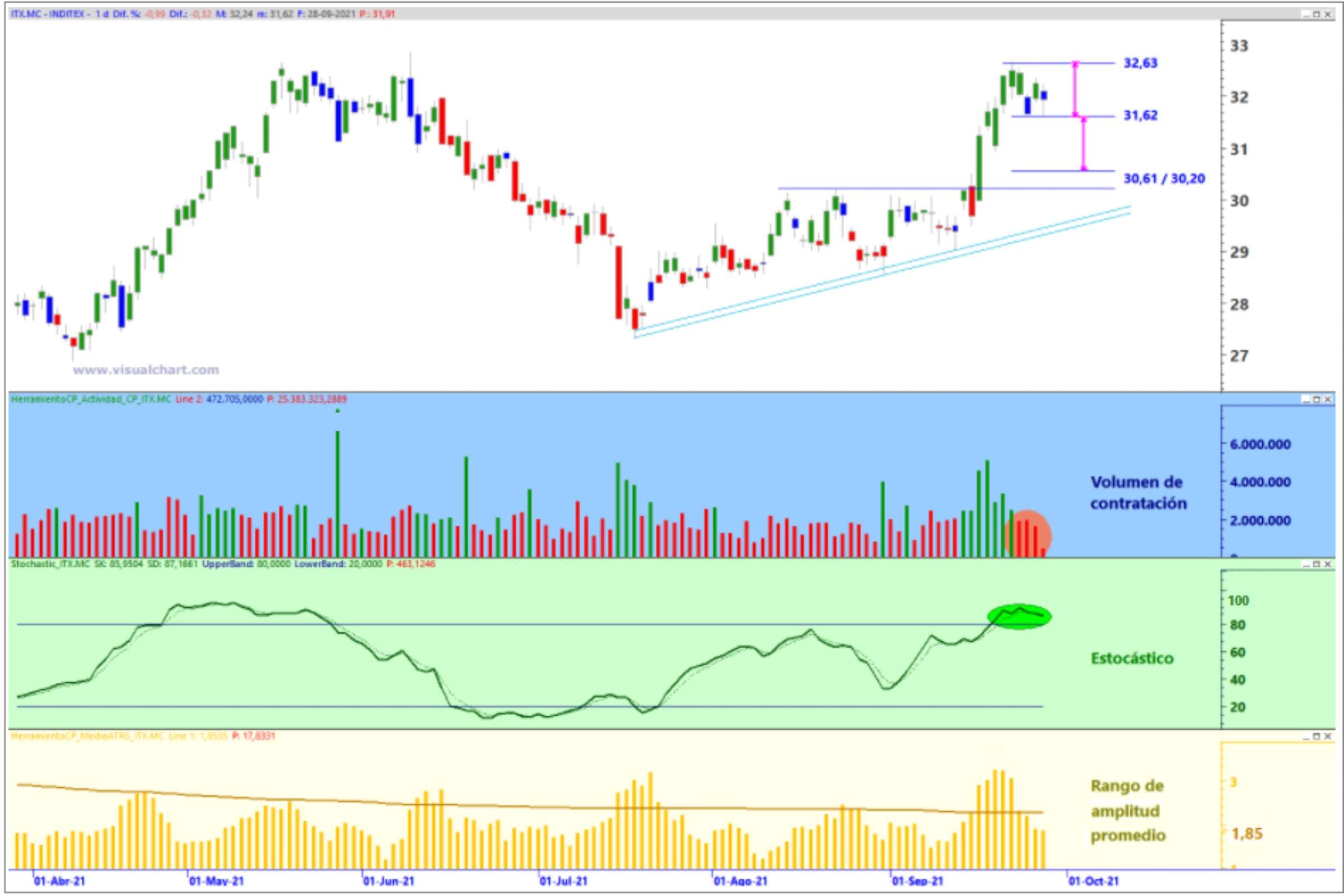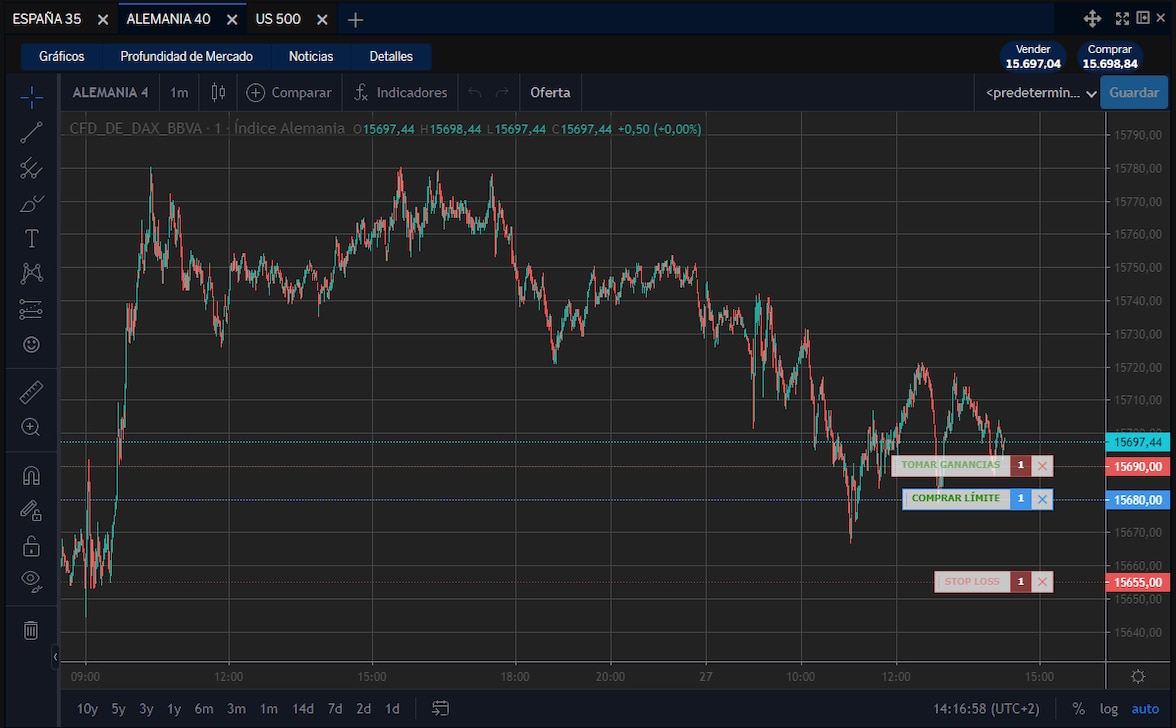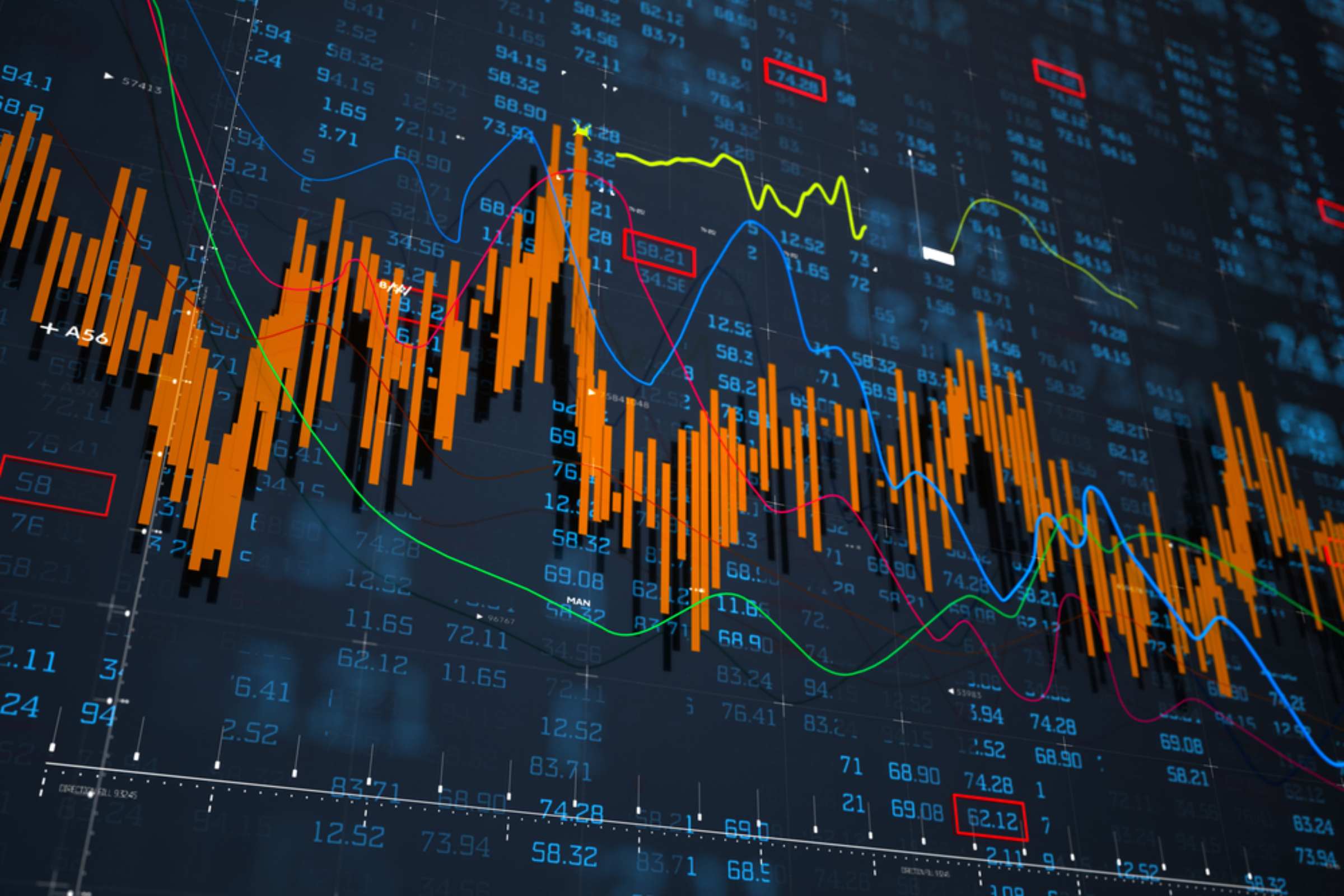-
What is BBVA Trader CFDs?
-
Margins and costs
-
Analysis
-
Information
Important:
CFDs are complex instruments that entail a high risk of quickly losing money due to leverage. 65.22% of retail investors lose money when trading CFDs with this provider. Make sure you understand how CFDs work and if you can afford the high risk of losing your money.
What are CFDs and how do they work?
CFDs are used to invest in an underlying asset (stocks, indexes, currencies, etc.), but without having to put up the total amount invested. Investing with CFDs requires a margin that is lower than the total equivalent amount of the direct investment in stocks or another underlying asset. This exposes investors to a leveraging effect for both gains and losses.
Once a CFD is purchased, each day's losses or gains will be settled daily in the investor's BBVA Trader account, based on that day's closing price, and on the previous day's (or the opening price of the position if purchased on that day).
These are very high-risk instruments that require the investor to monitor them constantly, as they can cause large losses due to leveraging.
If the required margin were to decrease without being replenished, the position will be closed automatically.
CFD contracts available at BBVA Trader CFDs
We have a wide range of CFDs available on the following underlying assets:
- The world's leading general and sector indexes.
- Stocks from the world's leading markets.
- Main currency pairs.
Don't have the BBVA Trade CFDs app yet?
Trade CFDs from your mobile with the BBVA Trader CFDs app
Who are CFDs for?
- CFDs are not suitable for all investors.
- This is a complex, leveraged and highly volatile product, which makes it very risky for investors.
- The resulting losses can be as high as the entirety of the funds that the customer has deposited in the BBVA Trader Cash Account.
- Due to the leveraging effect, the rate of loss is much higher than when buying the underlying asset directly.
For these reasons, they are only recommended for investors with extensive market experience and zero or low risk aversion.
See the fees of BBVA Trader CFDs
Costs of trading with CFD
When trading CFDs, it is important to know the potential costs associated with your trades. Below are the different costs associated with trading CFDs in BBVA Trader:
- Costs associated with CFD trading on stocks and indices plus: Brokerage cost (i.e. sales commission) and financing costs.
- Costs associated with trading CFDs over other assets: Spreads and financing costs.
In this section, we will explain each of these concepts in more detail.
Margins
| Type of CFD | Required margin |
|---|---|
| Type of CFD
Shares |
Required margin
From 20% |
| Type of CFD
Stock market indexes |
Required margin
From 5% |
| Type of CFD
Currencies |
Required margin
From 3.33% |
One of the main advantages, but also risks, of CFDs is the concept of leverage. We can see this in the following example:
To buy 1,000 shares in a company trading at €10, an investor has to pay €10,000. By contrast, by investing in CFDs, you can trade the same underlying asset by paying 20% of the position, in this case €2,000, with 5x leverage of this underlying asset.
Benefits of this trade with CFDs: If the underlying price goes up by 1%, with 5x leverage, as in the example, the amount in the margin account will go up 5%.
Risks of this trade with CFDs: By contrast, if the underlying asset drops by 1%, the margin account will see a 5% loss.
Spreads
The spread is the difference between the purchase and sale price of a given underlying asset. The purchase price will always be higher than the sale price. These prices will always be available in the buy screen, which allows us to check, at all times, the difference between the two prices, and therefore this cost.
The spread is one of the most important costs when trading CFDs. With the spread, the investor is incurring a cost when executing a trade. The smaller the difference between the purchase and sale price, the less the market movement needed to make a profit, since a smaller spread translates into lower costs for the investor. By contrast, the larger the difference between the purchase and sale price, the larger the market movement needed to make a profit, since a higher spread translates into higher costs for the investor.
Keep in mind that CFDs can have other costs in addition to the spread associated with them, such as overnight financing costs or transactions fees in the case of CFDs on stocks.
Example of spreads in BBVA Trader CFDs:
| Germany 40 Indexes | |
|---|---|
| Germany 40 Indexes
13,312.96 Sell |
13,314.76 Buy |
In this case, the spread of the Germany 40 index is €1.80. If you want to open a long position, you would buy at 13,314.76; by contrast, if you want to open a short position, you would sell at 13,312.96.
Spreads of BBVA Trader CFDs on the main underlying assets:
| Type of CFD | Spreads |
|---|---|
| Type of CFD
Spain 35 Index |
Spreads
5 |
| Type of CFD
Mini Spain Index |
Spreads
1 |
| Type of CFD
Germany 40 Index |
Spreads
1.8 |
| Type of CFD
Germany 40 Mini Index |
Spreads
0.4 |
| Type of CFD
US 30 Index |
Spreads
2.6
|
| Type of CFD
US 100 Index
|
Spreads
1.8
|
| Type of CFD
US 500 Index
|
Spreads
0.60
|
| Type of CFD
PLUS Indexes
|
Spreads
Market spread
|
| Type of CFD
Shares
|
Spreads
Market spread
|
| Type of CFD
EUR/USD
|
Spreads
0.0001
|
| Type of CFD
EUR/GBP
|
Spreads
0.0002
|
| Type of CFD
GBP/USD
|
Spreads
0.0002
|
Fees
Brokerage fee
In CFDs on stocks and indices plus, there is a purchase and sale fee on the notional amount of the trade each time a position is opened or closed. This fee is charged to the customer's cash account when the trade is made. For CFDs on shares, there is a minimum of €6 per transaction, which means that if the applicable fee does not exceed €6, the minimum charge of €6 will be applied. In the case of CFDs on indices plus, this fee ranges from EUR 2.5 to EUR 6 per contract, depending on the index plus being traded.
Telephone trades involving a CFD will have a surcharge of €9.95 per transaction or order executed, unless the system is not working.
Financing Cost
| Type of CFD | Long Position | Short position |
|---|---|---|
| Type of CFD
Shares |
Long Position
2.5% + benchmark interest rate*
|
Short position
2.5% - benchmark interest rate* |
| Type of CFD
Stock Indexes |
Long Position
2.5% + benchmark interest rate*
|
Short position
2.5% - benchmark interest rate* |
| Type of CFD
Currencies |
Long Position
1% - benchmark interest rate 1*,** + benchmark interest rate 2*,**
|
Short position
1% + benchmark interest rate 1*,** -benchmark interest rate 2*,** |
| Type of CFD
Indices Plus
|
Long Position
0% + benchmark interest rate*
|
Short position
0% – benchmark interest rate*
|
* The table below shows the list of the benchmark interest rates applicable to each CFD.
** Exchange rate 1 and exchange rate 2 are included in the calculation basis for the currencies, and both exchange rates represent the benchmark rates for the respective currencies. Example: For a long position in EUR/USD, currency 1 represents the Euribor 1M and currency 2 represents the SOFR.
Example of financing costs for a long position in a EUR/USD CFD with a notional value of 10,000 EUR with a one-day maintenance period
Daily financing cost = (Fixed rate - Euribor 1M + SOFR) x Notional EUR/365 = (1% - (-0.54%) + 0.15%) x 10,000 / 365 = 1.69% x EUR 10,000 / 365 = EUR 0.46.
List of benchmark interest rates:
| Currency | Benchmark interest rate |
|---|---|
| Currency
AUD |
Benchmark interest rate
BBSW 1M |
| Currency
CAD |
Benchmark interest rate
RUN |
| Currency
CHF |
Benchmark interest rate
SARON |
| Currency
CZK |
Benchmark interest rate
PRIBOR 1M |
| Currency
DKK
|
Benchmark interest rate
CIBOR-1M
|
| Currency
EUR |
Benchmark interest rate
EURIBOR 1M
|
| Currency
GBP
|
Benchmark interest rate
SONIA
|
| Currency
HKD
|
Benchmark interest rate
HKD ON Index Swap
|
| Currency
HUF
|
Benchmark interest rate
BUBOR 1M
|
| Currency
JPY
|
Benchmark interest rate
TONIA
|
| Currency
NOK
|
Benchmark interest rate
NIBOR 1M
|
| Currency
NZD
|
Benchmark interest rate
NZD-BKBM 1M (AVG)
|
| Currency
PLN
|
Benchmark interest rate
WIBOR 1M
|
| Currency
SEK
|
Benchmark interest rate
STIBOR 1 M
|
| Currency
SGD
|
Benchmark interest rate
SGD ON Deposit
|
| Currency
USD
|
Benchmark interest rate
SOFR
|
| Currency
ZAR
|
Benchmark interest rate
JIBAR 1M
|
Markets comment
Access live the real-time broadcasts on the pre-opening and opening of the stock markets in Europe, as well as the closing of the trading day.
* Please see important information on the Legal Notice included at the end of each video.
Market news
Trading ideas
Interactive chart
Trade from the chart with a single click. You can place your buy or sell order and modify or cancel pending orders directly from the graph tool.
More than 70 customizable technical analysis indicators
More than 50 charting tools.
See the fees of BBVA Trader CFDs
Upcoming courses, masterclasses and stock exchange webinars
Platform
Platform
-

How do I enter an order in BBVA Trader CFDs?
-

How do I link "stop loss" and "take profit" orders to a main order in BBVA Trader CFDs?
-

How do I put a dynamic stop order in BBVA Trader CFDs?
-

How do I create my own desktop at BBVA Trader CFDs?
-

How do I use the charts in BBVA Trader CFDs?
-

How do I monitor my margin in BBVA Trader CFDs?
-

How do I use the BBVA Trader CFDs transaction log?
Important notice
Please see the information of interest in the following attachment: Legal Notice.




























